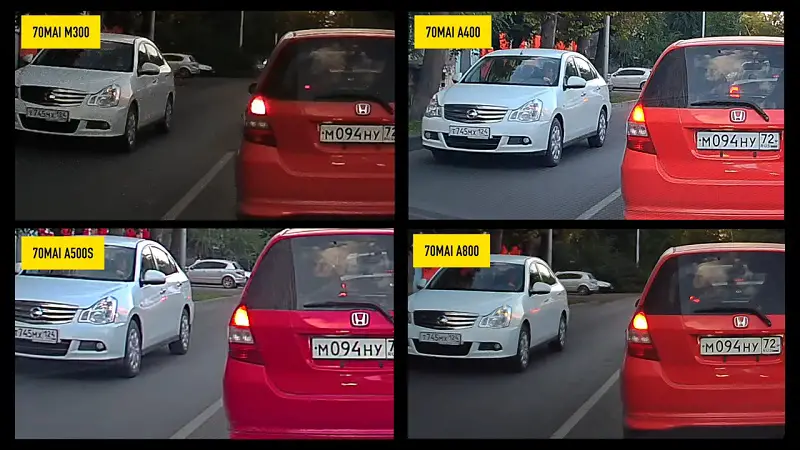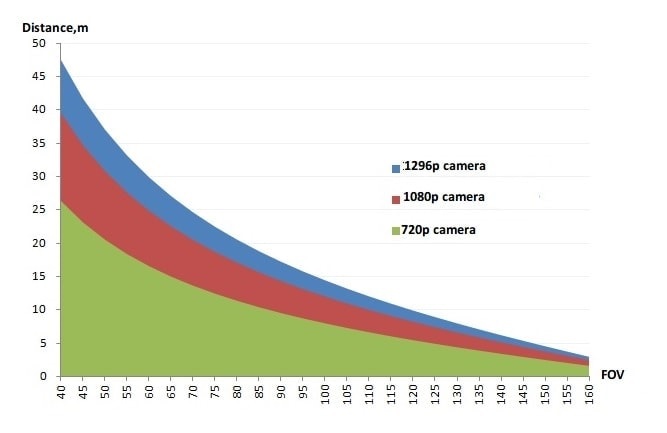With this dash cam buying guide, you will be able to learn what you should prioritize when choosing a dash cam.
The best dash cams in Malaysia should be able to capture clear video for both day and night times as well as operate normally under the hot sun.
Here are the 10 things you should consider when buying a dash cam:
- Video quality
- Field of view (FOV)
- Low light performance
- Lithium battery vs capacitor
- 1-channel, 2-channels or 3-channels dash cam
- Display screen
- Impact sensing
- WiFi connectivity
- Working temperature
- Parking surveillance
Table of Contents
Toggle1. Video quality
A good car camera recorder should be capable of recording at least 1080p. I would recommend getting a 1440p dash cam so that it can see further images clearer.
Below is a comparison of image quality captured by 70mai M300 (1080p), A400 (1440p) , A500S (1940p) and A800S (4K). You can see that the video quality of M300 is more blurry and noisy. This is because it has a lower resolution and a poorer image sensor.

However, higher definition recording is not necessarily a good feature as it will consume more data storage and also drain the battery faster (if the model has one). Personally, I don’t think a 4K recording is necessary for a dash cam.
2. Field of view (FOV)
The wider the field of view (FOV), the bigger the scene is captured. It can give you a clearer situation of what’s happening on the left and right-hand sides of your vehicle
As a rule of thumb, you should get a dash cam with at least a 140-degree field of view.
However, FOV itself is a double-edged sword. A wider FOV will compromise video quality because a 180-degree FOV video is more distorted than a 120-degree FOV video.
The chart below is an interesting find from zhihu.com (China’s version of Quora) showing the distance between dash cam and car plate where 720p, 1080p and 1296p cameras can capture the car plate clearly.

From the chart, it shows that higher video resolution 1296p gives you the furthest clear sight distance. As the FOV gets wider, the clear sight distance gets shorter. A 720p camera with a field of view of 160 degrees can only capture a clear image of a car plate from a distance of fewer than 5 meters.
3. Low light performance
A good dash cam should be able to record clear images at low-light conditions, through optimization of both hardware and software.
Actually, most dash cam, regardless of cheap or expensive, captures great video quality during the daytime when there is plenty of natural sunlight. But cheap knock off dash cams will record very poor video quality at night.
The best dash cams in the market usually are powered by Sony IMX image sensors like the IMX 335 and IMX 417.
The only way to review the low light video recording performance of a dash cam is to watch real footage on YouTube.
4. Lithium battery vs capacitor
On the internet, there are mixed opinions on whether lithium or capacitor dash cam is better.
Some reviewers say lithium-ion batteries in dash cams are bad since they easily swell or die after prolonged exposure to hot temperatures.
While some claim that the capacitor dash cams last longer and are able to work under extreme temperatures. But it would immediately shut off when your car engine is off. It fully relies on an external power supply if you want to use it for parking surveillance.
For average users, a lithium battery dash cam would work just fine.
5. 1-channel, 2-channels or 3-channels
The 1-channel dash cam only records the front view. 2-channels or dual-channel dash cam record front and rear view while the 3-channels dash cam covers front, rear and cabin view.
Dual-channel dash cams are recommended since accidents can occur from any direction.
A 3-channels dash cam is recommended for Grab drivers as it offers protection for both drivers and passengers. It discourages potential bad behaviours and any false accusation from passengers
6. Display screen
Some might argue that display screens are not important, but I disagree.
Personally, I prefer dash cams that come with a display screen.
Setting up a dash cam is easier with a display screen, and you can always see if the dash cam is recording correctly or if the camera angle has changed. So, you can make a quick adjustment.
7. Impact sensing
A good dash cam should have a built-in G-sensor that can detect any impacts on your vehicles.
Then, it should automatically record the footage of the incident.
It should also protect the recorded video from being overwritten for your proof of an accident
8. WiFi connectivity
The ability to connect via WiFi is an important feature of a dash cam. It allows you to access and download videos easily on the go.
9. Working temperature
The super capacitor dash camera usually performs better under the hot sun than a lithium battery dash camera.
If you regularly drive or park your car under the hot sun, it is wiser to stick with a super capacitor dash cam.
10. Parking surveillance
The feature of parking surveillance is only usually found in premium dash cams. Hard-wiring to a power supply is required to enable the 24-hour parking surveillance mode, making the installation process more difficult.
It is a great feature to have if you park your car frequently in public areas like condo parking, mall parking, or office parking lots.
Other Factors
There are other additional features that you can find on various high-end dash cams. Most of these features are good-to-have but they aren’t as critical as the ones mentioned above:
- Advanced driver assistance system (ADAS) – For me, this feature is of no importance since ADAS on dash cams have never been good enough or have provided any significant alerts
- Cloud backup – It is a great bonus feature, but you will need to provide a SIM card with an active mobile plan to use it. For average users, this might be too much trouble and costly.
- Internal backup memory – Another great feature to have. If the microSD card is damaged, it will automatically store recorded video in the dash cam’s built-in memory. And then automatically transfer to microSD card when a compatible microSD ard si
- Adhesive vs suction cup mount – Both mounting methods have their own pros and cons. Dash cams mounted with suction cups have a larger footprint and could be a bit annoying on the windscree.
- GPS – GPS-integrated dash cams provide additional information such as location and speed. This feature is very valuable as it makes the footage more convincing when an accident occurs.
- Voice recording – Almost all dash cams on the market today come with built-in microphones that can record voice. Therefore, it shouldn’t be a major concern.
- Size – Most dash cams on the market today are built in a small, discrete design. If you prefer the smallest form factor, then you should get a stick-type dash cam without a display screen.

